Last updated: November 28, 2022
Article
On the Edge: The Curious Lives of Intertidal Organisms and How We Monitor Them
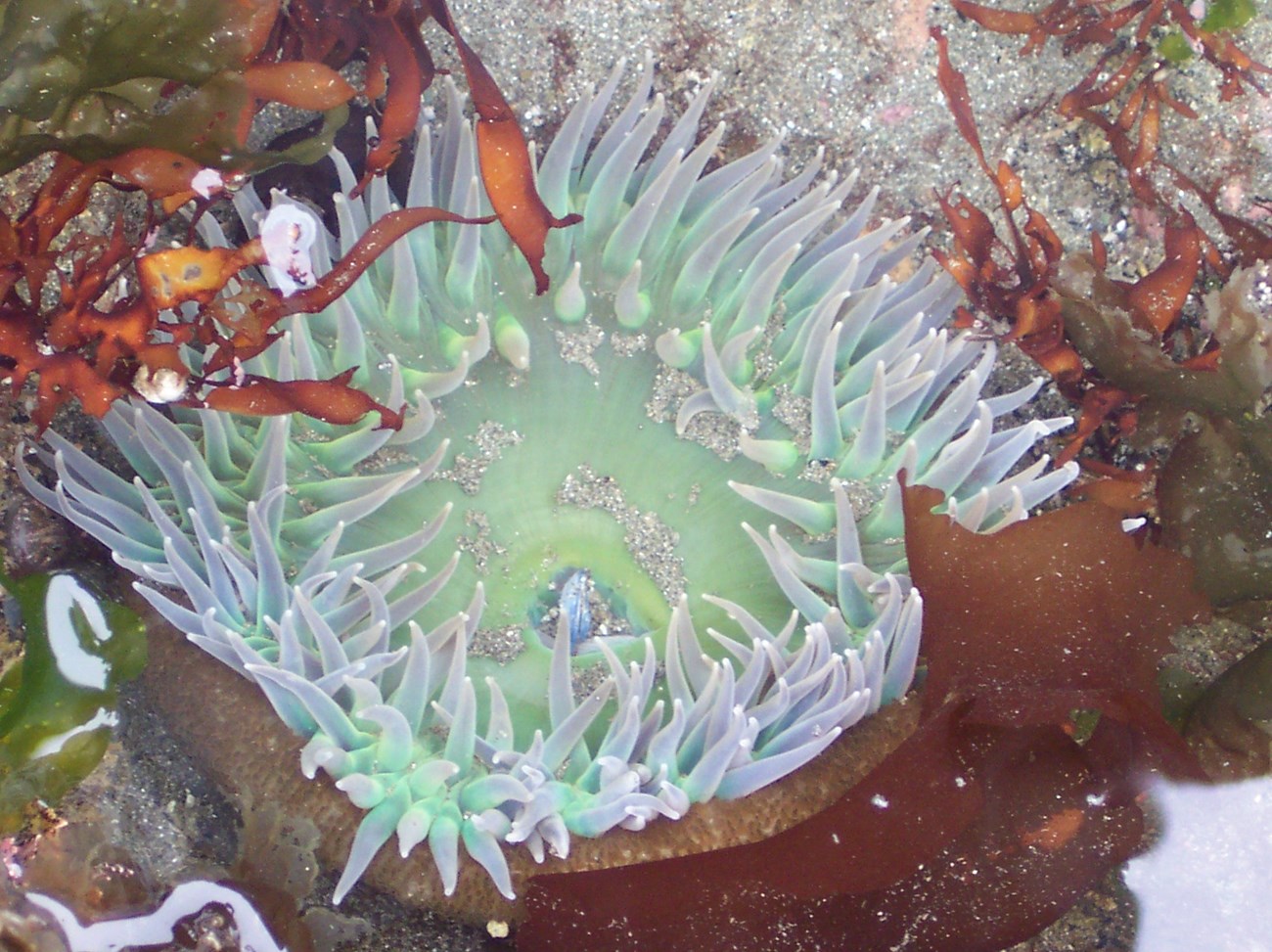
NPS
Imagine a trip to the Redwood National and State Parks. What do you see? The majestic trees, towering above you? Let’s go a bit further, past the trees. You travel past rivers and oak woodlands and prairies, and all the way to the coastline. There, just in front of you: a smattering of rocks, exposed by the low tide. You take a step closer and see water pooling between the rocks, a crab disappearing into the sand, an anemone waving hello, and perhaps a purple sea star, clinging to one of the rocks. You’ve discovered the rocky intertidal zone.
The rocky intertidal zone is a strange and magical place, home to an incredible diversity of invertebrate organisms adapted to life on the edge. The waters of the Pacific Ocean are incredibly productive. Ocean productivity refers to the amount of organic matter and nutrients in the water produced by tiny single-celled plant-like organisms called phytoplankton. In the late spring and early summer, upwelling (the movement of cold water to the surface) brings rich nutrients back to the water’s surface. Even the intertidal zone, at the margin of the ocean, benefits from high productivity. There is plenty of food available, but that doesn’t mean life is easy. The intertidal zone is vulnerable to the intense waves of winter and early spring, and to the daily change of tides. Twice a day, this environment completely changes.
If you visited an area at high tide, and returned at low tide, you might not recognize it. When tides are high, the rocky intertidal zone fills with fresh sea water. The waves can be forceful, and visiting fish pose a threat. At low tide, organisms are exposed to sunlight, air, and predatory mammals and seabirds. Sounds tough, right? How do these organisms survive?
A Delicate Balance: Life Strategies in the Intertidal Zone
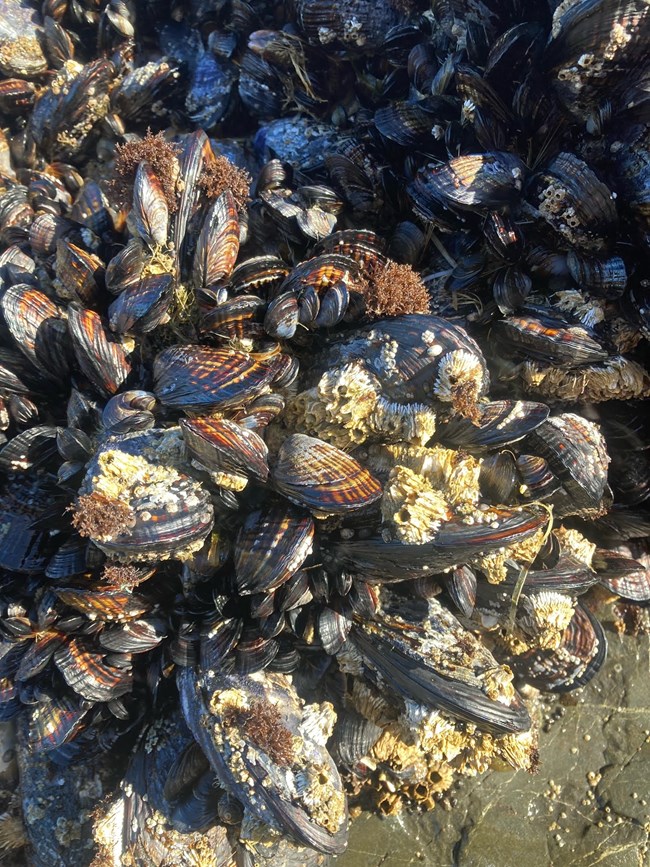
NPS
It turns out that intertidal organisms are cleverer than you might imagine. They have adapted to their harsh environment in a variety of ways. Some of these adaptations are behavioral. A behavioral adaptation is something an organism does in response to its environment. The intertidal zone can be divided into the spray zone, the high tide zone, the middle tide zone, and the low tide zone. The change of tides affects each subzone differently. The spray zone is rarely submerged unless tides are unusually high. The low tide zone is almost always submerged unless tides are uncommonly low. The high and middle tide zones experience the most change throughout the day. Because conditions vary among the subzones, organisms physically arrange themselves based on their tolerance for exposure to air and water, changes in temperature and salinity, and wave shock. This arrangement into zones is an example of a behavioral adaptation.
Other adaptations are morphological. Morphological adaptation means a physical trait or feature that gives the organism a better chance at survival. Some examples of morphological adaptations are hard exoskeletons for protection, strong tube feet for clinging, and flexible tissues for resisting pounding waves. Most organisms rely on a combination of morphological and behavioral adaptations to survive. Let’s take a closer look at some of these organisms and their specific adaptations.
To prevent washing away, barnacles produce a strong, glue-like substance that attaches them to rocks. This barnacle “glue” has inspired doctors and researchers to develop a surgical glue that can seal wounds on human organs. Depending on the species, barnacles may inhabit the spray zone, the high tide zone, or the middle intertidal zone.
Mussels are primarily found in the upper-middle tidal zone. Their strategy for surviving exposure to sunlight, air, and predators? Many individual mussels form beds, and attach themselves to rocks by producing byssal threads, strong, silky fibers made of proteins. Mussel beds provide food and shelter to other organisms by trapping water, sediment, and organic matter. Mussels have hard outer shells that help prevent them from desiccation (drying out). Still, they can’t go much above the high tide line.
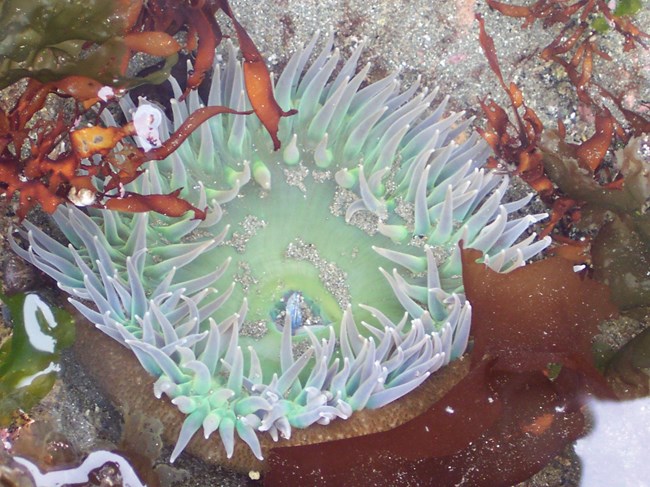
NPS
Anemones do things a little differently. Instead of a hard exterior to withstand the elements, they have soft, flexible tissues that can literally go with the flow. They mostly inhabit tidepools and the middle intertidal zone, where water is more plentiful. When the tide goes out, they fold in on themselves and become small blobs. Sand and shell fragments cover these blobs, and in this way, prevent desiccation. They can make themselves so small that you probably wouldn’t notice them unless you were looking very closely!
Barnacles, mussels, and anemones all stay in place, but what about more mobile organisms? Many of them, such as sea stars and urchins, have tube feet to get around. Tube feet are controlled by a water vascular system, which allows the animal to change the amount of water in its body. To extend its feet, the animal takes up more water. To retract its feet, the animal expels water. Sea urchins use their tube feet to hold them in place while they feed, but they can move around quickly by walking on their feet, spines, or teeth. Sea stars are sturdy with endoskeletons made of bony plates and strong tube feet that allow them to cling to rocks or move around. Sea stars can also use their tube feet to pry open mussels and evert their stomachs to ingest them. Chitons, a relative of snails and slugs, are covered in armor-like shell plates and have a muscular foot (not tube feet) that they use to slowly move around. If disturbed, a chiton will clamp down with its foot and lift its body slightly to create a vacuum effect. If it does fall off, it rolls into a ball, sort of like an armadillo.
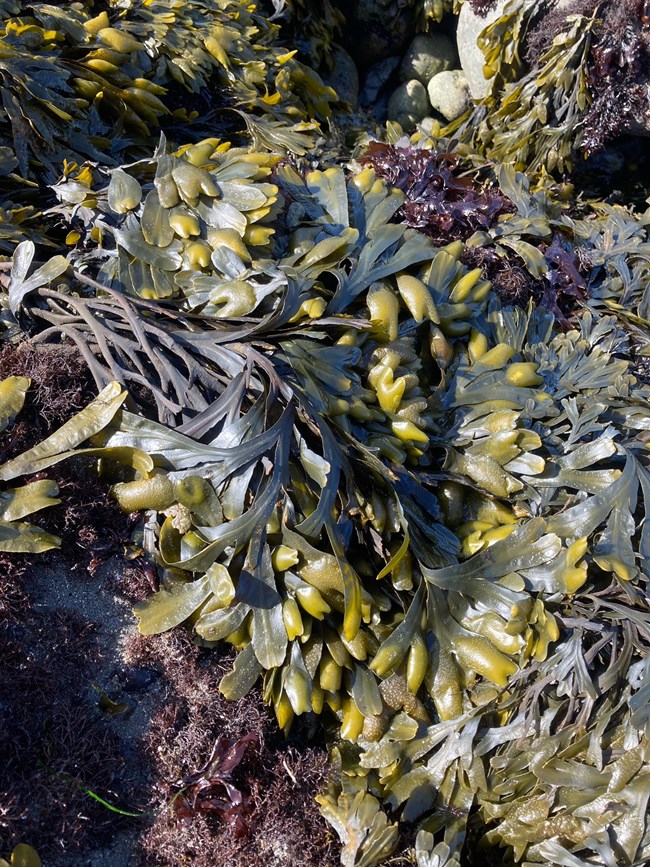
NPS
So far, we’ve looked at the invertebrate life in the intertidal zone, but we can’t overlook another crucial form of life: algae! As photosynthesizing organisms, algae are important primary producers in the intertidal zone. Macroalgae are the dominant algae in the intertidal zone and are visible to the naked eye. They include rockweeds, turfweed, and sea palm. Macroalgae attach themselves to rocks or even mussels and barnacles with an anchoring, root-like structure known as a holdfast. Like the anemone, macroalgae have soft and flexible tissues that can withstand the pounding waves. Grazing invertebrates such as limpets, chitons, and abalone rely on algae as a food source. Because algae often grow in dense clumps, they provide refuge from predators, pounding waves, and temperature changes. Some species of algae have close relationships with other organisms. For example, sea palm reproduces in mussel beds, but its juveniles can’t grow until a disturbance creates a bare patch in the mussel bed. Anemones host unicellular algae that in turn provide them with energy. These complex relationships are just a small glimpse into the world of intertidal organisms.
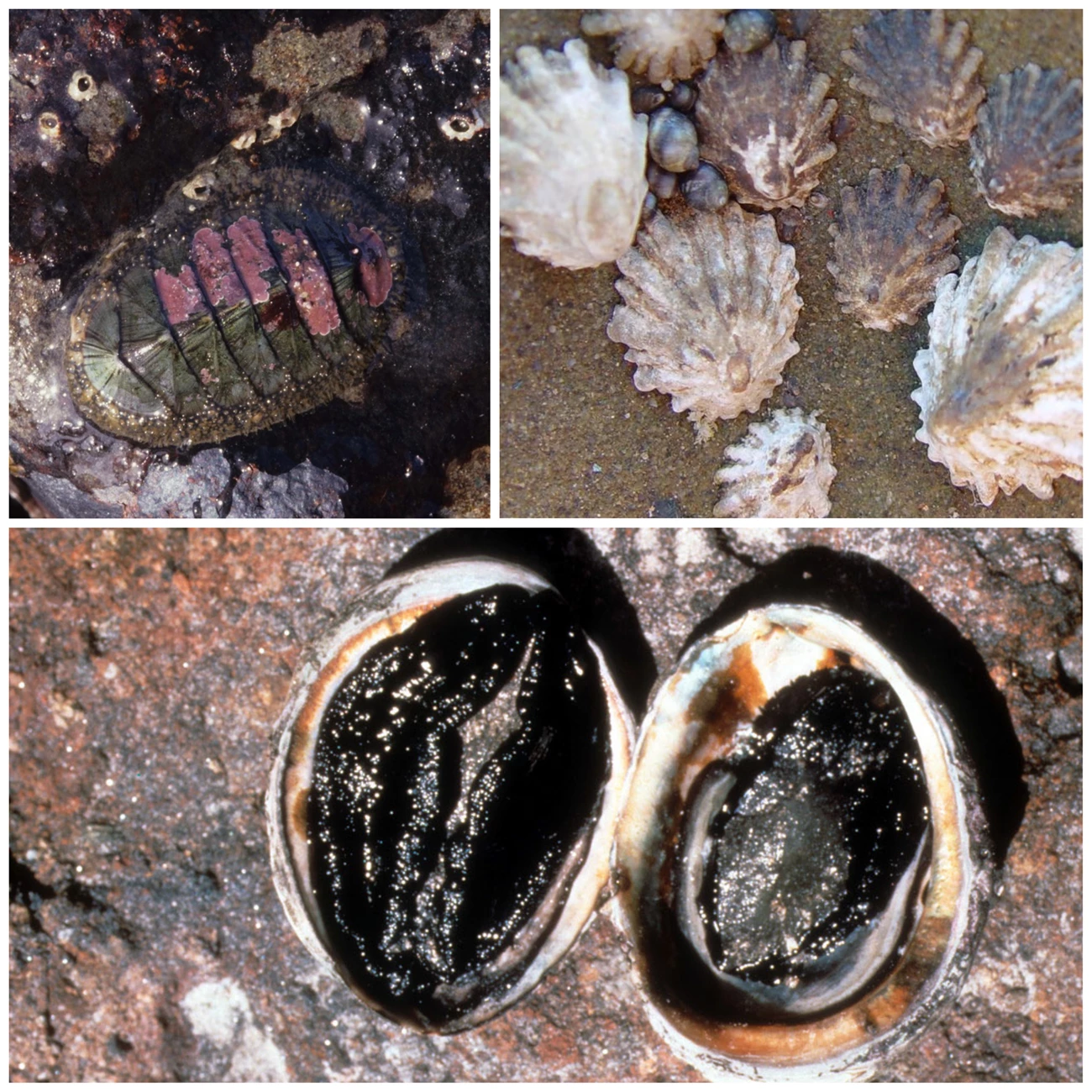
NPS
Keeping an Eye on the Rocky Intertidal Community
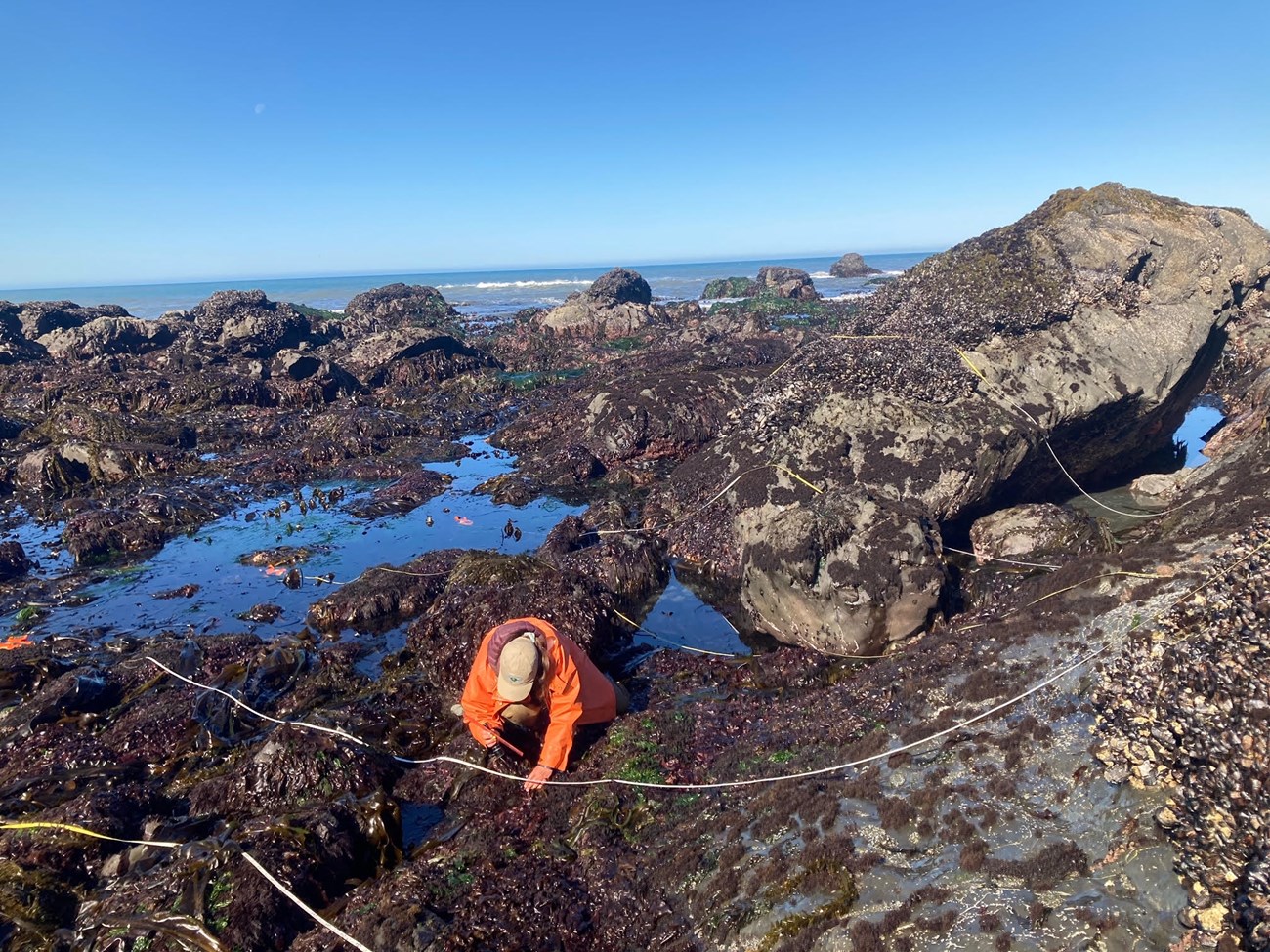
NPS
The rocky intertidal zone is resilient, but it is also delicately balanced. As we have just learned, changes in a single population could have major consequences on the food web. This is one of the reasons why it is important to monitor populations within the intertidal zone. A current example is sea star wasting disease, which has caused the ochre sea star to suffer major die offs since 2013. As a top predator in the intertidal food web, the ochre sea star is a keystone species. Keystone species have a disproportionate effect on their ecosystems relative to their population size. A major decline in sea stars could have a ripple effect on other populations. Monitoring offers an opportunity not only to track disease progress, but to monitor population decline and recovery among both sea stars and the many organisms they interact with.
In the Redwood National and State Parks (Del Norte County, Calif.), the Klamath Inventory and Monitoring Network has collaborated with University of California–Santa Cruz scientists to routinely monitor three rocky intertidal communities since 2004: Enderts Beach, Damnation Creek, and False Klamath Cove. These three sites are also part of the Multi-Agency Rocky Intertidal Network (MARINe), a coastwide monitoring program that includes several national parks as well as local and state governments, universities, and private organizations.
You may find yourself wondering: What do researchers look for? How do they collect data? Upon arriving at a site, researchers note the time of day, weather, tide level, presence of debris, and the count of birds, marine mammals, and humans. After their initial observations, researchers have two goals: assess the site’s biodiversity, and check in on the target species. At all the participating MARINe sites from California to Alaska, there is a list of core species that researchers may encounter at a site. These species are chosen using a set list of criteria. Researchers then select target species from that list based on their presence and abundance at a specific site. Each population is monitored using long-term, fixed plots. A fixed plot does not move, even if the species living in it move. Many of the target species are sessile, or sedentary, so their fixed plots are relatively small. Mobile organisms have larger fixed plots to accommodate their daily movement. At the three sites in Redwood National and State Parks, the target species are:
- Northern rockweed (Fucus gardneri)
- Dwarf rockweed (Pelvetiopsis limitata)
- Turfweed (Endocladia muricata)
- California mussel (Mytilus californianus)
- Barnacles (Chthamalus/Balanus)
- Surfgrass (Phyllospadix scouleri/torreyi)
- Ochre sea star (Pisaster ochraceous)
If a target species population changes, an invasive species arrives, or a disease starts appearing, researchers make sure to keep an eye on it. Between 2004 and 2018 at these three sites, some changes occurred, but there have been no major changes in community structure. For example, sometimes a storm event will remove all or part of a mussel bed, so the mussel population may decline. But over time, those mussels return, and the population recovers. Population recovery suggests that a community is stable. The Klamath Network regularly reports on intertidal community conditions at these sites.
The constantly changing conditions of the rocky intertidal zone characterize it as a disturbed ecosystem. Some aquatic and terrestrial ecosystems are disturbed primarily by human activity, but the rocky intertidal zone in Redwood National and State Parks is different. The natural disturbance of changing tides plays a much bigger role in shaping this ecosystem. Unfortunately, many rocky intertidal zones suffer from human impacts too. Sea-level rise and warming waters caused by climate change threaten all marine communities, as does pollution (especially plastic and oil). Intertidal zones can also be degraded by overuse. Because of the unique organisms that live there, tidepools are a popular destination for visitors, and not everyone is well-educated on how to visit without harming organisms. Human impacts, large and small scale, can upset the delicate balance in this incredible ecosystem. This is not to say that people shouldn’t visit! We just need to tread lightly and treat the intertidal zone with respect.
Let’s return to your trip. Perhaps you found a sea star, a bed of mussels, and an anemone. Perhaps a shore bird landed nearby and flew off with a crab in its beak. Whatever you saw, hopefully you have a better understanding for this incredible place, and hopefully you are curious to learn more. When the tide begins to come in again, you retreat onto the sand and watch as this magic little world disappears under the water. It is hidden for now, but it will be back tomorrow. Will you?
Further Reading
Visit the Redwood National and State Parks website for more information on getting to Enderts Beach, Damnation Creek, and False Klamath Cove, ocean safety, and responsible tide-pooling.
Explore the MARINe website to learn more about target species, monitoring protocols, and the participating sites along the coast.
Learn more about the Klamath Network rocky intertidal monitoring program.
Article by Natalie DiNenno, Southern Oregon University science writing intern for the Klamath Network, as part of the Fall-Winter 2022 Klamath Kaleidoscope newsletter.
